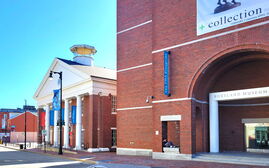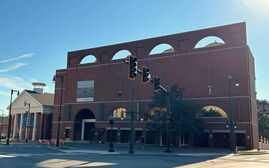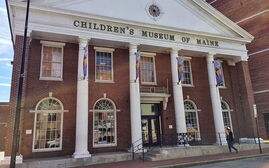A Look Back: The cultivation of Congress Square
 File photo / Peter Van Allen
In 1994, the Portland Museum of Art's Payson Building, shown here in a recent file photo, was barely a decade old. The Children's Museum of Maine had recently moved into 142 Free St, the building shown at the left.
File photo / Peter Van Allen
In 1994, the Portland Museum of Art's Payson Building, shown here in a recent file photo, was barely a decade old. The Children's Museum of Maine had recently moved into 142 Free St, the building shown at the left.
Portland’s arts scene was putting down roots in 1994, and many of them were planted in and around Congress Square.
The Maine College of Art — today, the Maine College of Art & Design — was converting the landmark Porteous Building on Congress Street into a new campus. Artist studios were sprouting up nearby. The Children’s Museum of Maine had recently moved to 142 Free St.
As Biz (as Mainebiz was known then) reported in December 1994, city leaders were drawing up plans for what would soon become the Arts District. Seeding much of the downtown area’s creative economy was the Portland Museum of Art.
The PMA opens onto Congress Square via the Charles Shipman Payson Building, which was barely 11 years old in 1994. With the new building, Biz wrote, annual visits to the PMA had blossomed eightfold to 120,000 in 1992.
In 2024, however, it looks as if Congress Square’s renaissance has begun to wilt.
Many of Portland’s artists have transplanted to cheaper studios, although the college is thriving. COVID and a tough economy have shuttered storefronts. The Children’s Museum, which merged with the Children’s Theatre of Maine in 2008, today operates in a $15 million, purpose-built center at Thompson’s Point.
The PMA attracted 170,000 visitors in 2019. But the numbers have been down since the start of the pandemic. The museum now wants to rejuvenate Congress Square and the city’s art scene with a planned $100 million expansion. It calls for replacing the former Children’s Museum building, which dates to 1830, with a new wing that would double the PMA’s current space.
The PMA says the expansion would grow visits by 76%, add hundreds of jobs and millions of tourism dollars, and be as revolutionary today as the Payson Building was decades ago. Critics say the plan would destroy a key element of the Congress Street Historic District, and violate the letter and spirit of the city’s preservation ordinance.














0 Comments